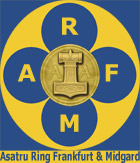
Asatru Ring Frankfurt & Midgard
Living with the Gods. Living for the Gods. Living
through the Gods.
The
Poetic Edda Online
In the translation of
Bellows
Lays of the Gods
Drap Niflunga
The Slaying of The Niflungs
INTRODUCTORY NOTE
It has been already pointed out (introductory note to Reginsmol) that the compiler of the Eddic collection had clearly undertaken to formulate a coherent narrative of the entire Sigurth cycle, piecing together the various poems by means of prose narrative links. To some extent these links were based on traditions existing outside of the lays themselves, but in the main the material was gathered from the contents of the poems. The short prose passage entitled Drap Niflunga, which in the Codex Regius immediately follows the Helreith Brynhildar, is just such a narrative link, and scarcely deserves a special heading, but as nearly all editions separate it from the preceding and following poems, I have followed their example.
With Sigurth and Brynhild both dead, the story turns to the slaying of the sons of Gjuki by Atli, Guthrun's second husband, and to a few subsequent incidents, mostly late incorporations from other narrative cycles, including the tragic death of Svanhild, daughter of Sigurth and Guthrun and wife of Jormunrek (Ermanarich), and the exploits of Hamther, son of Guthrun and her third husband, Jonak. These stories are told, or outlined, in the two Atli lays, the second and third Guthrun lays, the Oddrunargratr, the Guthrunarhvot, and the Hamthesmol. Had the compiler seen fit to put the Atli lays immediately after the Helreith Brynhildar, he would have needed only a very brief transitional note to make the course of the story clear, but as the second Guthrun lay, the next poem in the collection, is a lament following the death of Guthrun's brothers, some sort of a narrative bridge was manifestly needed.
Drap Niflunga is based entirely on the poems which follow it in the collection, with no use of extraneous material. The part of the story which it summarizes belongs to the semi-historical Burgundian tradition (cf. introductory note to Gripisspo), in many respects parallel to the familiar narrative of the Nibelungenlied, and, except in minor details, showing few essentially Northern additions. Sigurth is scarcely mentioned, and the outstanding episode is the slaying of Gunnar and Hogni, following their journey to Atli's home.
Drap Niflunga
The Slaying of the Niflungs
Gunnar and Hogni then took all the gold that Fafnir had had. There was strife between the Gjukungs and Atli, for he held the Gjukungs guilty of Brynhild's death. It was agreed that they should give him Guthrun as wife, and they gave her a draught of forgetfulness to drink before she would consent to be wedded to Atli. The sons of Atli were Erp and Eitil, and Svanhild was the daughter of Sigurth and Guthrun. King Atli invited Gunnar and Hogni to come to him, and sent as messenger Vingi or Knefröth. Guthrun was aware of treachery, and sent with him a message in runes that they should not come, and as a token she sent to Hogni the ring Andvaranaut and tied a wolf's hair in it. Gunnar had sought Oddrun, Atli's sister, for his wife, but had her not; then he married Glaumvor, and Hogni's wife was Kostbera; their sons were Solar and Snćvar and Gjuki. And when the Gjukungs came to Atli, then Guthrun be sought her sons to plead for the lives of both the Gjukungs, but they would not do it. Hogni's heart was cut out, and Gunnar was cast into the serpent's den. He smote on the harp and put the serpents to sleep, but an adder stung him in the liver.
Home - Poetic Edda - Next Guthtrunarkvitha II
© Michael Schütz – Asatru Ring Frankfurt & Midgard – www.asatruringfrankfurt.de